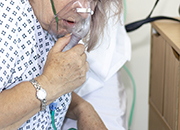FRIDAY, May 8, 2020 (HealthDay News) — You’re sick, perhaps very sick, so you head to the local emergency department fearing the onset of COVID-19. But what symptoms most clearly point to a need for urgent care?
Based on a review of more than 1,000 patients who’ve already sought care for respiratory illnesses since the coronavirus was declared a pandemic in March, researchers at Harvard Medical School are offering up a new list of symptoms to watch out for.
First of all, fever isn’t necessarily at the top of the list.
“Fever is not a reliable indicator” of COVID-19, said a team led by Pieter Cohen. He’s an associate professor of medicine at Harvard and a physician with the Cambridge Health Alliance, in Boston.
Often, people who show up at hospital ERs with respiratory symptoms have only slightly elevated body temperatures, the researchers noted. They added that other symptoms are often more specific to COVID-19.
“COVID-19 may begin with various permutations of cough without fever, sore throat, diarrhea, abdominal pain, headache, body aches, back pain and fatigue. It can also present with severe body aches and exhaustion,” Cohen’s group explained in a Harvard news release.
Another key sign of coronavirus illness: A loss of the sense of smell within the first few days of symptom onset.
And what really sets more serious cases of COVID-19 apart is something that’s almost never seen in influenza or other respiratory illnesses: severe shortness of breath.
“In serious COVID-19, shortness of breath is a critical differentiator from other common illnesses,” Cohen’s group said.
Shortness of breath — a feeling that you can’t fill your lungs with air as you normally do — almost never appears within the first day or two of the onset of other symptoms. But it “can appear four or more days after onset of other symptoms,” the team added.
Shortness of breath can also occur in an anxiety-induced panic attack, and of course the fear that you might have COVID-19 could spur such an attack.
But the shortness of breath that is indicative of clinical COVID-19 manifests somewhat differently, the research team said.
First of all, “anxiety-induced shortness of breath occurs rapidly, seemingly out of the blue, while COVID-19 shortness of breath tends to develop gradually over a few days,” the researchers noted. And when shortness of breath comes from a panic attack, it typically occurs when a person is at rest or trying to fall asleep.
In contrast, COVID-19 shortness of breath “gets worse with physical exertion, including performing simple daily activities like walking, climbing stairs or cleaning,” the researchers said.
Shortness of breath tied to COVID-19 is a real warning sign that a person might need to seek medical help because of a dangerous dip in oxygen levels in the blood. “Blood oxygen levels can drop precipitously with exertion, even in previously healthy people,” the team said.
Doctors can quickly monitor blood oxygen levels using a simple finger-clip device called a pulse oximeter. Once COVID-19 shortness of breath has been diagnosed, these patients might be released back home, but will still require “very close monitoring and frequent follow-up to check how the shortness of breath is evolving, and whether a patient may be deteriorating and may need to go to the hospital,” the team said.
“Early recognition and proper triage are especially important given that, in the first days of infection, people infected with [the new coronavirus] may experience symptoms indistinguishable from a variety of other acute viral and bacterial infections,” Cohen added.
Cohen’s team published their findings April 20 in the Mayo Clinic Proceedings journal. The study is based on more than 1,000 patients seen at a COVID-19 outpatient clinic in Boston.
Reading over the new report, New York City emergency medicine physician Dr. Robert Glatter said, the findings “mirror the clinical picture of patients that I continue to see.”
Some patients come to his department at Lenox Hill Hospital without any drop in blood oxygen, but with “fatigue, muscle aches [and] often loss of smell,” Glatter said. These patients are still able to eat and drink and they’re typically discharged back home.
“There is also a subgroup of stable patients — with mild symptoms and mild hypoxia [low blood oxygen] — who, after careful evaluation, can be safely discharged and monitored in the home-setting with pulse oximetry and frequent telemedicine follow-up to check for progression of symptoms,” he added.
“But most important, we must pay close attention to those patients who experience worsening and new symptoms — chiefly difficulty breathing or chest discomfort up to a week after onset of symptoms, along with fever — who then present for re-evaluation in the emergency department,” Glatter said.
It’s these patients who are most at risk for the onset of a “cytokine storm” — a very dangerous condition where the immune system’s response to the new coronavirus runs amuck.
When blood oxygen levels fall too low, these patients may require hospital admission, Glatter said.
So, “it’s important to look at all aspects of patients’ concerns along with their chief complaint when they present to the emergency department — chiefly the timeline and course of their symptoms — when evaluating patients who may be at risk for complications and progression of COVID-19,” Glatter said.
More information
Visit the U.S. Centers for Disease Control and Prevention for more on the symptoms of COVID-19.
Copyright © 2025 HealthDay. All rights reserved.

